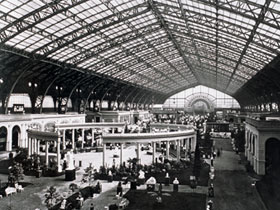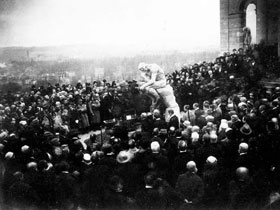 By 1900, Rodin had achieved the fame and influence he had long sought. European nobility paid him tribute and an entire pavilion was devoted to his work at the Paris World Exposition. One hundred sixty-eight bronze, marble, and plaster works were displayed here. Drawings and photos adorned the walls and lectures were given explaining his techniques. People visited from all over the world. His work was immensely popular and requests for exhibitions arrived from as far away as Montreal and Tokyo. Rodin was successful on an international scale.
By 1900, Rodin had achieved the fame and influence he had long sought. European nobility paid him tribute and an entire pavilion was devoted to his work at the Paris World Exposition. One hundred sixty-eight bronze, marble, and plaster works were displayed here. Drawings and photos adorned the walls and lectures were given explaining his techniques. People visited from all over the world. His work was immensely popular and requests for exhibitions arrived from as far away as Montreal and Tokyo. Rodin was successful on an international scale.
This incredible popularity did not slow his production. He made new sculptures from old pieces, modeled portrait busts of well-known people, and completed several long term projects, including the Monument to Victor Hugo and an enlarged version of The Thinker. During these later years, he took a great interest in studying dancers, part of his desire to capture natural, spontaneous movement. Commissions flooded in. It has been speculated that Rodin had as many as fifty assistants working for him during these decades. In 1908, Rodin moved his studio and showroom to the Hôtel Biron in Paris. The rent was very low and Rodin was able to occupy much of the ground floor. Several other famous or soon-to-be-famous tenants were there, including writer Jean Cocteau, painter Henri Matisse, and dancer Isadora Duncan.
Before he died, Rodin insured his fame and legacy. He proposed to bequeath to France his entire estate, including the contents of his studios (in the Hotel Biron in Paris and another outside Paris in Meudon), as well as the rights to continue to cast his sculpture after his death. In exchange, Rodin could reside at the Hôtel Biron for the remainder of his life and France would convert the Hotel to a museum for his work after he died. After much debate, the French parliament agreed.
 Rodin married his lifetime companion, Rose Beuret, on January 29, 1917. She died three weeks later and Rodin died shortly after her, on November 17, 1917. Friends and dignitaries came to Rodin’s funeral at Meudon to see him laid to rest beside Rose Beuret with The Thinker at the base of his tomb.
Rodin married his lifetime companion, Rose Beuret, on January 29, 1917. She died three weeks later and Rodin died shortly after her, on November 17, 1917. Friends and dignitaries came to Rodin’s funeral at Meudon to see him laid to rest beside Rose Beuret with The Thinker at the base of his tomb.
The Life of Rodin: Legacy
At the time he died Rodin had achieved his goal, to transform sculpture into something alive, emotive, evocative, passionate, and modern. Using all that was offered up by the sculpture of previous centuries, his work created a readiness for the world to accept the aesthetics of those who followed. There is no modern sculpture without Rodin.